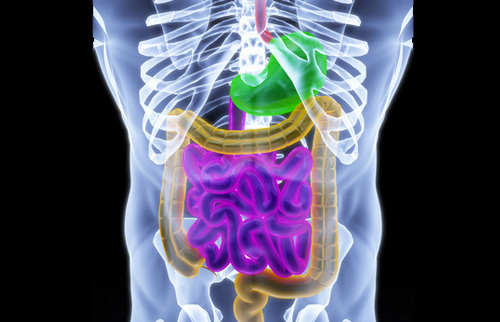Researchers at the Institute for Systems Biology (ISB) in Seattle have identified distinct signatures in the human gut microbiome that are associated with either healthy or unhealthy aging trajectories, and which in turn could help to predict survival in a population of older individuals. The team’s combined analysis of gut microbiome, phenotypic, and clinical data from more than 9,000 adults of different ages, showed that the gut microbiome becomes increasingly unique (i.e., increasingly divergent from others) as individuals age, starting in mid-to-late adulthood.
“Interestingly, this uniqueness pattern appears to start in mid-life—40–50 years old—and is associated with a clear blood metabolomic signature, suggesting that these microbiome changes may not simply be diagnostic of healthy aging, but that they may also contribute directly to health as we age,” said ISB research scientist Tomasz Wilmanski, PhD, first author of the team’s paper in Nature Metabolism. ISB professor Nathan Price, PhD, co-corresponding author of the paper, added: “This is exciting work that we think will have major clinical implications for monitoring and modifying gut microbiome health throughout a person’s life.” The team’s report is titled, “Gut microbiome pattern reflects healthy aging and predicts survival in humans.”
The gut microbiome has important effects on human health, but its significance to the human aging process is unclear, the authors noted. Studies have shown that the ecological dynamics of the human gut microbiome change during early life, and then remain relatively stable, but again start to display gradual changes with advancing age. “Particularly in older populations (65+ years), studies over the past few years have revealed a number of associations between gut microbiome composition and measures of physical fitness, frailty, and diet, highlighting the importance of proper gut microbiome function into the later decades of human life,” the authors wrote.
However, they continued, although scientists are working to increase our understanding of the human gut microbiome, relatively little is known about when age-associated changes in the gut microbiome may start, how these changes might affect how our body functions, and whether aging patterns within the gut microbiome just reflect, or perhaps actually contribute to, long-term health and lifespan. “Importantly, identifying aging patterns within the gut microbiome could have major clinical implications for both monitoring and modifying gut microbiome health throughout the human lifespan,” the scientists suggested.
For their reported studies, the ISB team and their collaborators analyzed gut microbiome, phenotypic, and clinical data from over 9,000 people aged between 18 years and 101 years—across three independent cohorts. The team focused, in particular, on longitudinal data from a cohort of over 900 community-dwelling older individuals (78–98 years old), allowing them to track health and survival outcomes.
The data showed that individuals’ gut microbiomes became increasingly unique (i.e., increasingly divergent from others) as they aged, starting in mid-to-late adulthood, and this corresponded with a steady decline in the abundance of core bacterial genera (e.g., Bacteroides) that tend to be shared across humans.
Strikingly, while microbiomes became increasingly unique to each individual in healthy aging, the metabolic functions the microbiomes were carrying out shared common traits. “… individual gut microbiomes became increasingly more unique to each individual with age, starting in mid-to-late adulthood, and this uniqueness was positively associated with known microbial metabolic markers previously implicated in immune regulation, inflammation, aging, and longevity,” the scientists noted.
This gut uniqueness signature was highly correlated with several microbially derived metabolites in blood plasma, including one—tryptophan-derived indole—that has previously been shown to extend lifespan in mice. Blood levels of another metabolite—phenylacetylglutamine—showed the strongest association with uniqueness, and prior work has shown that this metabolite is highly elevated in the blood of centenarians. “This unique signature can predict patient survival in the latest decades of life,” said Wilmanski, who led the study. Healthy individuals around 80 years of age showed continued microbial drift toward a unique compositional state, but this drift was absent in less healthy individuals.
Increasing age-related microbiome uniqueness was associated with blood metabolomic signatures that indicated the microbiome might be directly related to health as individuals age. For example, indoles are known to reduce inflammation in the gut, and chronic inflammation is thought to be a major driver in the progression of aging-related morbidities. “The authors noted, …in the later decades of human lifespan, healthy individuals continued to show an increasingly unique gut microbial compositional state (associated with a decline in core taxa) with age, whereas this pattern was absent in those in worse health … Indole (the precursor to the human microbial co-metabolite indoxyl sulfate identified in our analysis) has been shown to increase healthspan and extend survival in a number of animal models.”
The analysis supports the notion that the adult gut microbiome continues to develop with advanced age in healthy individuals, but not in unhealthy ones, and that microbiome compositions associated with health in early-to-mid adulthood may not be compatible with health in late adulthood. “Prior results in microbiome-aging research appear inconsistent, with some reports showing a decline in core gut genera in centenarian populations, while others show relative stability of the microbiome up until the onset of aging-related declines in health,” said microbiome specialist Sean Gibbons, PhD, co-corresponding author of the paper. “Our work, which is the first to incorporate a detailed analysis of health and survival, may resolve these inconsistencies. Specifically, we show two distinct aging trajectories: 1) a decline in core microbes and an accompanying rise in uniqueness in healthier individuals, consistent with prior results in community-dwelling centenarians, and 2) the maintenance of core microbes in less healthy individuals.”
The authors concluded, “A striking finding in our analysis was that increasing compositional uniqueness both reflected healthy aging and predicted survival in older adults. This suggests that the gut microbiome may not only reflect, but also potentially contribute to, a longer host lifespan, which is consistent with some recent non-human animal studies … As our understanding of the aging microbiome increases, monitoring and identifying modifiable features that may promote healthy aging and longevity will have important clinical implications for the world’s growing older population.”



